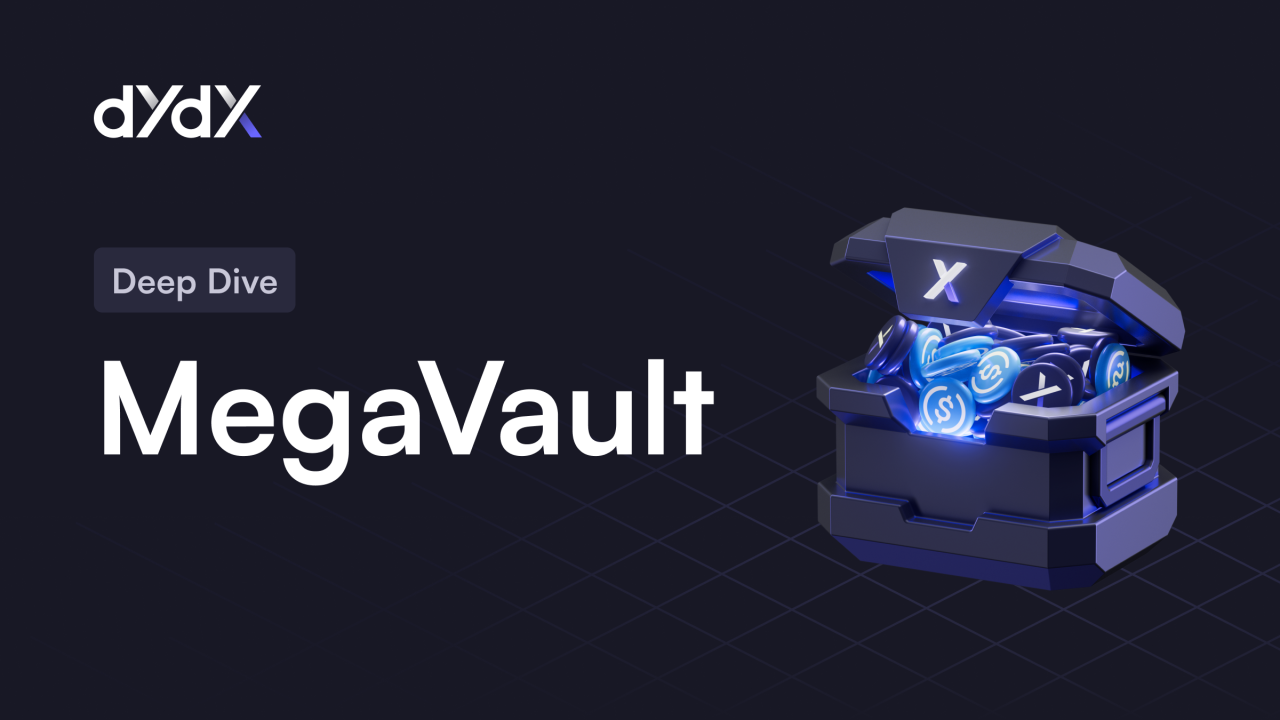


TLDR
MegaVault is a user-facing feature that enables dYdX Chain users to deposit USDC to provide liquidity to markets and receive yield in return
MegaVault uses deposited USDC to automatically market-make across various markets
MegaVault is under active development and will be released in the coming months. Functionality mentioned is subject to change.
Overview
MegaVault is a user-facing feature which will enable dYdX Chain users to deposit USDC, provide liquidity to various markets and earn yield in return. The deposited USDC is used to run automated market-making strategies across dYdX Chain markets.
Users will be able to deposit USDC into MegaVault anytime and start accruing yield immediately. Users will be able to withdraw their USDC from the vault at any time.
Yield can come from various sources: PnL on vault positions, trading fee revenue shares, and other potential incentives devised by the community and software deployers.
An “operator”, elected via governance, manually handles operational tasks such as moving USDC between markets and adjusting parameters.
MegaVault will give deployer communities a tool to dramatically improve the trading experience on all markets by enabling the protocol to scale liquidity on any market. At the same time, it provides users an attractive option to earn yield.
Vault Mechanics
At a technical level, MegaVault will operate multiple “sub-vaults.” A “sub-vault” uses deposited USDC to run an automated market-making strategy for a given market.
When users deposit USDC into MegaVault, it will allocate the deposited USDC to market-specific “sub-vaults.” Yield generated across all “sub-vaults'' will be aggregated and distributed to the MegaVault depositors.
Deposits and Withdrawals
Users will be able deposit USDC into MegaVault at any time and start earning yield immediately. At a high-level, depositors can think of deposits as owning a percentage of the vault’s net equity (i.e. vault’s USDC and position values).
In the initial version of MegaVault, users will be able to withdraw from MegaVault at any time after depositing, though users may experience “slippage” based on MegaVault’s status and positions as well as market conditions.
In future iterations, withdrawals could be subject to potential lockup periods or other restrictions in certain scenarios. For example, deposits linked to new market listings could require the deposits to be locked up for X days.
Operator
Initially, MegaVault will require a few manual operations, such as:
1. Moving USDC between market-specific “sub-vaults”
2. Adjusting “sub-vault” parameters that control the vault’s quoting strategy and behaviors (i.e. how defensive or aggressive the quoting strategy is and the size of quotes).
An “operator,” assigned via governance, handles these tasks.
In future iterations of dYdX Chain software, an “operator” may no longer be necessary as the feature becomes more fully automated.
FAQ
Where does the MegaVault yield come from?
Yield can come from various places. Examples include: PnL on vault positions, funding rate payments, trading fee revenue share, and other protocol incentives.
Certain parameters, such as what portion of trading fee revenue to share with MegaVault, can be configured by governance or any deployer of the dYdX Chain software.
2. Can MegaVault depositors lose money?
Yes. MegaVault does not guarantee positive yield, as it depends on many factors including market conditions, vault positions, etc. For example, if the vault has a long position and the price drops, then the vault’s net equity decreases. In this example, the depositor’s percent ownership of the vault remains the same, but the value of the ownership decreases.
3. How much yield can depositors expect?
Yield is not guaranteed. This is because the performance of the MegaVault depends on many factors that are outside of the protocol’s control.
4. What sort of restrictions can be placed on withdrawals?
The initial version of the software feature will have no restrictions on withdrawals. Future iterations may allow for lockup periods in certain scenarios such as withdrawals linked to new market listings. More details will be provided in the future.
5. Why would withdrawals incur “slippage?”
When withdrawing from MegaVault, “slippage” can occur due to increased leverage from collateral outflows or the need to close positions to cover withdrawal outflows.
6. Will users be able to directly interact with “sub-vaults?”
No – not initially at least. Users cannot directly deposit into or withdraw from “sub-vaults.”
7. When will MegaVault be available?
MegaVault is in active development and will be available in the coming months.
Terms and Conditions: This document provides information with respect to the default settings of the dYdX Chain open source software (”dYdX Chain”) developed by dYdX Trading Inc. (“dYdX”). The dYdX Chain feature described is under development and its characteristics may be subject to change. dYdX does not deploy or run dYdX Chain software for public use, or operate or control any infrastructure for any dYdX Chain deployment. dYdX is not responsible for any actions taken by other third parties who use or deploy dYdX Chain. dYdX services and products are not available to persons or entities who reside in, are located in, are incorporated in, or have registered offices in the United States or Canada, or Restricted Persons (as defined in the dYdX Terms of Use). Prior to using or deploying any aspect of dYdX Chain third parties should independently review and abide by local and applicable law. The content provided herein does not constitute, and should not be considered, or relied upon as, financial advice, legal advice, tax advice, investment advice or advice of any other nature, and you agree that you are responsible to conduct independent research, perform due diligence and engage a professional advisor prior to taking any financial, tax, legal or investment action related to the foregoing content. The information contained herein, and any use of v4 software, are subject to the v4 Terms of Use.